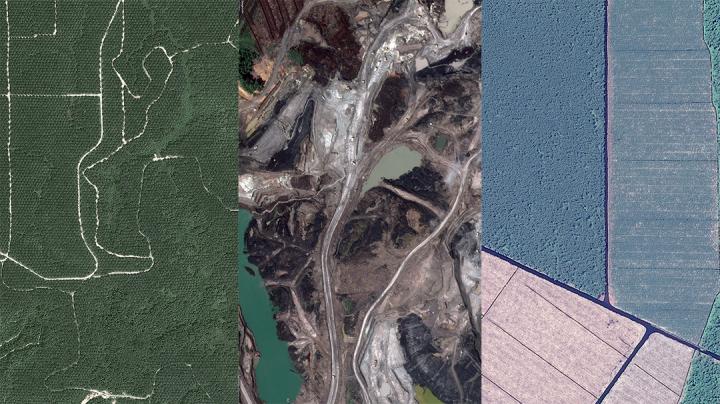Wildfire and mining join plantations as threat to forests; conservation policies and practices should reflect this

Credit: (Credits: 1) CNES/Airbus; 2) DigitalGlobe; 3) CNES/Airbus.)
DURHAM, N.C. — Large-scale agriculture, primarily for growing oil palms, remains a major cause of deforestation in Indonesia, but its impact has diminished proportionately in recent years as other natural and human causes emerge, a new Duke University study finds.
“In the late 2000s, large-scale plantations were responsible for more than half of Indonesia’s loss of primary natural forests,” said Kemen G. Austin, a 2018 doctoral graduate of Duke’s Nicholas School of the Environment, who led the study. “This trend peaked from 2008 to 2010, when an average of 600,000 hectares of forest was lost annually — 57 percent of it driven by the expansion of these massive farms.”
“From 2014 to 2016, an average of more than 800,000 hectares of primary forest was lost annually, but large-scale plantations accounted for only 25 percent of it,” Austin said. “So although the overall rate of deforestation grew, other causes were responsible for most of it.”
The conversion of forests to grasslands rose sharply in 2015 and 2016 when El Niño caused severe drought and higher-than-normal fire activity on many of the nation’s islands, she noted.
Small-scale farming, which has largely been overshadowed by plantation-scale agriculture as a driver of deforestation, was also found to play a bigger role, accounting for about one-quarter of all forest loss. This suggests the importance of designing forest management interventions that take the values and requirements of small-holder farmers into account too, said Austin, who is now a senior policy analyst at RTI International.
Mining and logging roads were also found to be important drivers of deforestation at different times during the study, particularly on the local level.
“The takeaway message for policymakers and conservationists is that the causes of forest loss in Indonesia are much more varied than we previously thought. They change from place to place and over time,” Austin said. “Even though oil palm is the first thing that pops into most people’s head when they think about deforestation in Indonesia, it’s not the only cause, and we need to adjust our policies and practices to account for that.”
Austin and her colleagues published their peer-reviewed findings Feb. 1 in Environmental Research Letters.
Their study is the first to document the changing causes of deforestation occurring in Indonesia at the national scale and at the local level on each of the country’s major developed islands. Some global studies previously have included nationwide data from Indonesia, Austin noted, but not at such a fine scale.
“Using 15 years of high-spatial-resolution Google Earth imagery and newly available global datasets on forest loss let us zero in on the causes of deforestation at each location and see how they vary from place to place and over time,” Austin said. “For instance, logging is still driving deforestation on the island of Papua, but on Sumatra and Kalimantan, it’s the oil palm industry and El Niño-driven fires that are the primary drivers.”
Indonesia has experienced one of the highest rates of primary natural forest loss in the tropics in recent years. The loss of these forests — which absorb and store vast amounts of climate-warming carbon dioxide, provide habitat for thousands of species, and help control erosion and flooding — has become a cause of global environmental concern.
The declining role of large-scale agriculture in causing forest loss of late may stem from the success of conservation policies the Indonesian government has put into place since 2011 and by voluntary commitments to sustainability by corporations that own or manage oil palm or timber plantations, Austin said. It could also be driven by economic factors, such as falling commodity prices or increased international competition.
###
Amanda Schwantes, Yaofeng Gu and Prasad Kasibhatla, all of Duke’s Nicholas School of the Environment, co-authored the new study.
Funding came from the National Science Foundation (grant #DGE-1106401) and from the Nicholas School.
CITATION: “What Causes Deforestation in Indonesia?” Kemen G. Austin, Amanda Schwantes, Yaofeng Gu and Prasad Kasibhatla. Environmental Research Letters, Feb. 1, 2019. DOI: 10.1088/1748-9326/aaf6db
Media Contact
Tim Lucas
[email protected]
919-613-8084
Original Source
https:/
Related Journal Article
http://dx.




